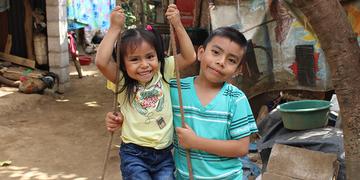Help Children in Mexico
Mexico, officially the United Mexican States, is a nation rich in cultural heritage, as well as modern-day extremes, such as affluence and poverty, natural splendor and urban blight.
It has the second-largest economy in Latin America, and is a major oil exporter. But prosperity remains a distant dream for many Mexicans. Rural areas are often neglected, and huge shanty towns ring the cities. In 2017, back-to-back earthquakes left parts of the country devastated and in need of emergency assistance.
Moreover, this region of the world has long been plagued by violence and drug trafficking, in addition to political, economic and social concerns, driving many to cross the U.S. border in search of a better, safer life. That’s why we’re hard at work for children – including those at risk in Mexico, those on the move, and those at the U.S. border.
You can help save Mexico’s children, growing up in one of the world’s most challenging places to be a child.
Challenges for Children in Mexico
Many living in extreme poverty, with the second highest number of children in high-intensity conflict zones, Mexican children need your help.
1 child in 77 dies before their 5th birthday, 2 times the U.S. rate
10% of children suffer from stunting due to malnutrition
8% of children are out of school
16% of girls (ages 15-19) are married, and 1 in 17 gives birth
5 in every 100,000 is murdered
46% of people live in poverty

Our Results for Children in Mexico
Because of supporters like you, we’re making a difference in Mexico, including helping reduce child labor by a remarkable 80% since 2000. Together, we changed the lives of over 95,000 children in Mexico last year.

Little ones in Mexico are able to grow up healthy, educated and safe, thanks to supporters like you.
28,000 children healthy and nourished
19,000 children educated and empowered
46,000 children protected from harm
3,000 children lifted from poverty
1,000 children aided in crisis
Our Work for Children in Mexico
Since 1973, Save the Children has been a leading charity for children in Mexico through programs in education, health and hygiene, nutrition, violence prevention, eradication of child labor and exploitation, and rapid response in emergencies. And in 2017, our emergency response experts helped support children following destructive earthquakes.
Save the Children is one of the only charities responding on both sides of the regional migration crisis, and the leading charity focused on the unique needs of children in U.S. border transit shelters at the U.S.-Mexico border.
We’re working to keep children safe and healthy and to support their learning as the situation continues to evolve. Our network of partners shelters families on both sides of the border with a focus on strengthening the capacity of border communities to protect children and address their immediate physical and emotional needs. We offer resource support, technical guidance, children’s programming and advocacy.
We also continue to address the root causes of migration through our work in Central America’s Northern Triangle, where we have longstanding programs for children and families in El Salvador, Guatemala, Honduras, as well as Mexico.
Here are some recent examples of our work:
A healthy start in life
- We’re teaching children the importance of good nutrition and hygiene through playful workshops and educating parents on why kids with good health develop and learn better, so children stay in school and reach their full potential
- Through our Call for Well-Being: Children Growing Healthy through Good Nutrition and Fitness project, we’re working to improve children’s nutrition and physical fitness through schools and community-based programs
- We conducted a water study and installed new filtration systems, as well as conducted training sessions about the maintenance and importance of clean water
The opportunity to learn
- We’re strengthening elementary schools, bringing community members together to improve the quality of care and education children receive
- We’re using innovative methods to train teachers on how to teach math and literacy in fun and engaging ways
- We’re offering children and their families tools to help them grow and thrive socially and emotionally
- We addressed the need for multi-lingual education in Spanish and Mayan
- Through our Skills to Succeed program, we’re helping youth, ages 15-21, acquire the skills to successfully complete the transition to livelihoods and decent work, which can break the intergenerational cycle of poverty
Protection from harm
- We implemented our Healing and Education through the ARTS (HEART) program for young children and adults, training educators, delivering art kits and conducting evaluations
- We’re working with girls and boys, as well as their families, to help them see each other as equals who deserve to achieve their full potential
Emergency response
- In 2017, our emergency response experts responded to two devastating earthquakes, supporting the immediate and long-term needs of children and families, including creating child-friendly spaces, providing health and hygiene supplies and providing essential emotional support, as well as restoring education and helping communities rebuild
How to Help Children in Mexico
You can create change that lasts a lifetime for children in Mexico and beyond– in so many ways.
Donate
Support Save the Children’s mission. Donate to help children in Mexico and around the world grow up healthy, educated and safe.
Join Team Tomorrow
Join Team Tomorrow and your monthly donation will go toward addressing the needs of children affected by today’s most urgent issues.
Browse the Gift Guide
Give a meaningful gift that will help transform children’s lives and futures in Mexico and beyond. There’s something for everyone!
Sources: Facts and statistics have been sourced from Save the Children’s monitoring and evaluation experts, as well as our thought leadership publications, including our Global Childhood Report 2020 and Stop the War on Children 2020 report. Other sources include CIA World Factbook and BBC Country Profiles.
Photo: Save the Children Mexico.




